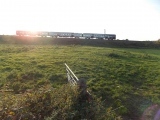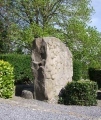Andy Burnham's Blog, page 165
August 1, 2021
Cloghmacow
Sometimes listed as a stone circle but in fact a radial-stone cairn. These are classified as a mound constructed primarily of stone which is delimited by a series of spaced stones set with their long axes aligned towards the centre of the cairn. Their precise function is unknown though through association with stone circles and stone rows they belong to the wider ritual tradition of the middle/late Bronze Age (c. 2400-500 BC).
Published on August 01, 2021 01:57
July 31, 2021
Butley Barrow
This bowl barrow is passed by thousands of people every day without them realising it is there as it is by the main road and railway line just north of Macclesfield. In a narrow, low-lying farmers field so only accessible with permission but can easily be seen from the car on Bonis Hall Lane whilst waiting at the traffic lights, or on foot from the farm gate on the main road.
Published on July 31, 2021 08:32
July 29, 2021
Higgin's Well
A legend associated with this well will be familiar to many - the story goes that the landowner didn't like people visiting the well and filled it in. The well's water then started to arise through his house, so he re-opened it! More details in Anne's comment below. The present structure is Victorian. It is found along a path to the left of the church.
Published on July 29, 2021 04:02
July 26, 2021
Westbury White Horse
One of a set of hill figure illustrations by Eric Ravilious painted in 1939. Now available as a set of postcards from Rather Good Art. An exhibition celebrating the art of Ravilious opens on the 25th of September at Wiltshire Museum.. Tradition has it that the original white horse on this site was cut to commemorate King Alfred's defeat of Guthrun in 879. However, the earliest mention seems to be by the Reverend Wise in his 1742 book "Further Observations on the White Horse and other Antiquities in Berkshire". The present version of this hill figure was cut in 1778 by the steward of Lord Abingdon. With concrete added to hold the edging stones in place during the early twentieth centure, the horse was finally totally covered in concrete in the 1950s and again in 1990s.
Published on July 26, 2021 09:29
Casterton
An embanked stone circle or ring cairn in Cumbria which is not in the Burl books. It has an adjacent earthwork enclosure and there is extensive evidence of early settlement in this area. A stunningly beautiful place, looking west over the Lune valley above Kirkby Lonsdale, and south to Pendle, down the course of the Belinus Line. The stones barely peep out of the turf, giving the distinct feeling that if the surface was lowered, much of interest would emerge.
Published on July 26, 2021 08:58
Glaisdale Low Moor West
This line of stones, one of many such groups in the Glaisdale area marks the north - south trail across the western part of Glasidale Low Moor from where it crosses Busco Beck to the main bridleway which runs east - west across this part of the moor. These stones are marked W1 to W4 on the uploaded sketch map that I have uploaded.
Published on July 26, 2021 08:52
July 25, 2021
Japanese Chronology for Dolmen (early Yayoi era, 3000-300 BCE)
Dolmens in Japan distribute mainly in the northwestern Kyūshū islands. Dolmen construction technology seems to have been introduced from the Korean peninsula, which is one of the dolmens most densely distributed areas and contains three UNESCO World Heritage registered dolmen sites. They developed a peculiar regional style on Jeju island, but curiously no dolmen has been discovered on Tsushima and Iki islands which lie between the Korean peninsula and Kyūshū island.
Published on July 25, 2021 03:29
July 24, 2021
Pierre qui Pousse (Haulchin)
This menhir is a textbook example of landenian sandstone. Also, the clearly trapezoidal shape (just the tip is missing) is typical of the menhirs of this region of Belgium. It was unearthed in October 1951 and moved to the centre of the village of Haulchin, because it was a nuisance for farming activities.
Published on July 24, 2021 07:20
July 23, 2021
Hanazono Rugby Stadium
A modern homage to Stonehenge which sits outside the Hanazono Rugby Stadium, near Osaka. This is not one of the Olympic venues but I thought it would still be an appropriate way to mark the opening of the Tokyo 2021 Olympic Games.. Aska writes: In the garden in front of Hanazono Rugby Stadium there stands a rather poor copy of Stonehenge. It seems to symbolize the origin of rugby in England. The stadium was the first to be constructed in Japan, built in 1929, and is 'holy ground' for youth rugger because the National High School Rugby Tournament is held here on New Years Eve. And also it was the venue for 2019 World Rugby Cup.
Published on July 23, 2021 03:48
Carnedd Fach
A truly massive pile of stones (pictured right in the top photo) - the remains of what is thought to be a burial cairn from probably the Bronze Age. Situated on the ridge above Cwm Lloer. It is circular, measuring approx 20m in diameter and up to 3.5m in height. It has been disturbed in the past, with several drystone shelters constructed and a modern walker's cairn crowning the summit.
Published on July 23, 2021 03:27













